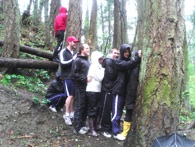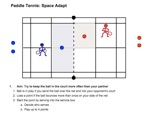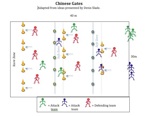Welcome to archive of EPHE 452 games units based on TGfU


The unit plans were created after the students had been introduced to Bunker and Thorpe’s (1986) TGfU approach for the first time in an upper level PE teaching methods course. The course integrated together practical sessions, technical skills of teaching (progressions, feedback, organization, etc.,), professional literature (over a 100 practitioner and research articles) and a four-lesson field experience. The course emphasized a situated learning and complex system frameworks to inform the use of a TGfU model to understand games teaching (Hopper, Butler and Storey, 2009). The course also drew on direct model of instruction and the Sport Education model (Sidentop, 2002).
The pre-service teachers gradually shifted from a student-mindset in university classes to a teacher-mindset as they observed and then taught the beginning of a games unit arranged in a variety of local school sites. Thirty to Thirty-two pre-service teachers taught in pairs in different PE programs ranging from grade 5 to 12. Within the field experience the pre-service teachers completed a comprehensive field observation booklet that guided them to observe class routines, physical layout, student engagement and teacher interactions. This contextual information was drawn on to create draft units of instructions and detailed lesson plans. Each pre-service teacher taught a lesson on their own and with their peer. Each lesson was observed, documented and reflected upon using teacher/peer feedback and whole class time-on-task analysis. After this field experience the pre-service teachers re-wrote their unit plans as they created using iWeb a web-based unit drawing on the field experience and their on-going reading of the literature. The whole class experience was co-ordinate through a course Moodle portal that allowed sharing of ideas in a discussion forum, article summaries and course materials.
The visual literacy enabled by the iWeb platform allowed the pre-service teachers to re-represent the tactical ideas they had tried in their field experience. The visual form combined with explanatory text strengthened their commitment to the TGfU model as they played and shared ideas to create the web-based units.
References
Bunker, B., & Thorpe, R. (1986). The curriculum model. In R. Thorpe, Bunker, D., & Almond, L (Ed.), Rethinking games teaching (pp. 7-10). Loughborough: University of Technology, Loughborough.
Hopper, T., Butler, J., & Storey, B. (2009). TGfU...Simply Good Pedagogy: Understanding a Complex Challenge. Ottawa: PHE Canada.
Metzler, M. (2005). Instructional models for physical education (2nd ed.). Scotsdale: Holcomb Hathaway.
Siedentop, D. (2002). Sport education: A retrospective. Journal of Teaching in Physical Education, 21(4), 409.
Overview of Course in Uvic PE program

Dr Tim Hopper’s Website






